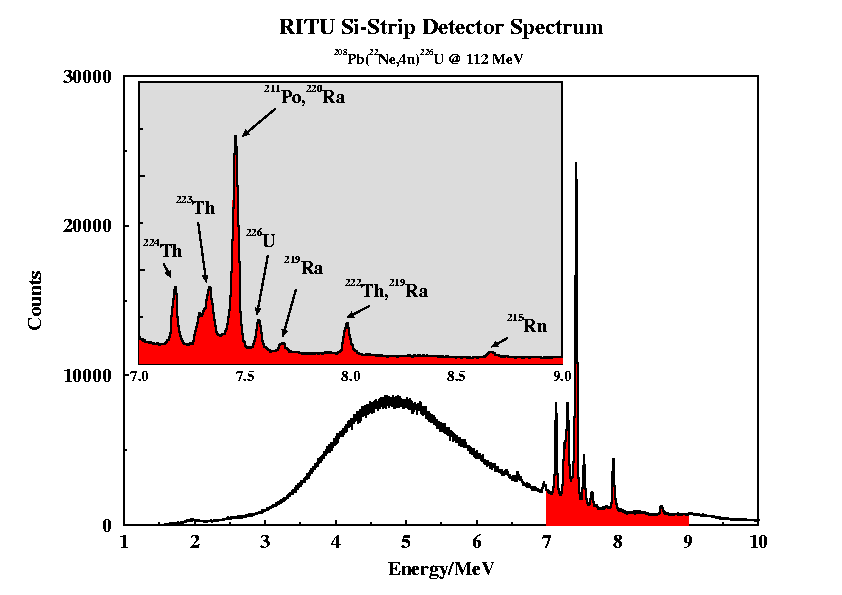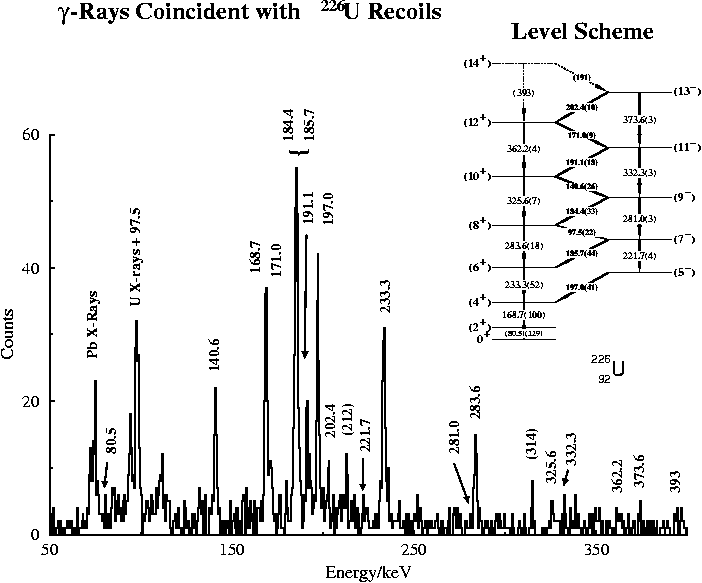
Many of the nuclei that we know of are non-spherical, or deformed. In many cases, it is possible to understand the rotational band structures that we observe in terms of a rotating spheroidal shaped nucleus. Since these nuclei are symmetric under reflection, the members of the rotational band will all have the same parity. The observation of low-lying negative-parity states in the 1950's led to the suggestion that some nuclei may possess shapes which are asymmetric under reflection, or pear-shaped.
The strength of the octupole interaction can be inferred from the spectra that we observe. The figure below shows some of the possiblities.

 3 = 0 in its ground state. The nucleus is,
however, unstable to octupole vibrations about its spheroidal equilibrium shape,
giving rise to low-lying negative-parity states.
3 = 0 in its ground state. The nucleus is,
however, unstable to octupole vibrations about its spheroidal equilibrium shape,
giving rise to low-lying negative-parity states.
 3.
There is an infinite barrier between the two minima at ±
3.
There is an infinite barrier between the two minima at ±
 3, and the nucleus cannot take on a reflection
symmetric shape. Here, the negative parity states are perfectly interleaved with
the positive parity states.
3, and the nucleus cannot take on a reflection
symmetric shape. Here, the negative parity states are perfectly interleaved with
the positive parity states.
 3, separated by a
small barrier. In this case the nucleus can tunnel through the barrier to the
reflection symmetric shape, giving rise to parity splitting between the
positive- and negative- parity states.
3, separated by a
small barrier. In this case the nucleus can tunnel through the barrier to the
reflection symmetric shape, giving rise to parity splitting between the
positive- and negative- parity states.
The two figures below show spectra obtained using the JUROSPHERE Ge
detector array and the RITU gas-filled recoil separator. The upper figure is the spectrum
obtained from the RITU focal plane Si-strip detector. The broad distribution to
the left corresponds to the implantation of fusion-evaporation residues from
the 22Ne + 208Pb reaction at a bombarding energy of 112 MeV.
The peaks at around 7.5 MeV correspond to the subsequent
 decay of the implanted recoils.
decay of the implanted recoils.

The lower figure shows  rays which
occurred in coincidence with recoils followed by an
rays which
occurred in coincidence with recoils followed by an  decay of energy 7.57 MeV, within a time interval of 800 ms after the recoil implant.
This corresponds to the characteristic
decay of energy 7.57 MeV, within a time interval of 800 ms after the recoil implant.
This corresponds to the characteristic  decay of 226U.
decay of 226U.

The figure above shows the level scheme obtained through energy
sum and intensity balance arguments from the  -ray spectrum.
The figures in brackets are the total transition intensities normalised to that of
the 4+ to 2+ transition. Note the similarity to the intermediate
case in the potential energy figure, and the reduction in parity splitting with increasing spin.
-ray spectrum.
The figures in brackets are the total transition intensities normalised to that of
the 4+ to 2+ transition. Note the similarity to the intermediate
case in the potential energy figure, and the reduction in parity splitting with increasing spin.

The figure above shows the difference in experimental
aligned angular momentum,
 ix = ix- - ix+,
between the negative- and positive- parity bands as a
function of rotational frequency,
ix = ix- - ix+,
between the negative- and positive- parity bands as a
function of rotational frequency,

 , for
the N = 134 isotones: 226U, 224Th, 222Ra and
220Rn. It can be seen from this plot that the behaviour of
, for
the N = 134 isotones: 226U, 224Th, 222Ra and
220Rn. It can be seen from this plot that the behaviour of
 ix for
226U follows closely that of 224Th and 222Ra,
nuclei which are considered to be octupole deformed, like the intermediate case in the
potential energy figure. At low
values of
ix for
226U follows closely that of 224Th and 222Ra,
nuclei which are considered to be octupole deformed, like the intermediate case in the
potential energy figure. At low
values of

 ,
,
 ix has a value of
approximately 1.5
ix has a value of
approximately 1.5
 and tends towards zero with
increasing rotational frequency, this can intrepreted as evidence
for the enhancement of octupole strength with rotation. At higher rotational
frequency, the pairing correlations are weaker, which increases the moment of
inertia. Also, the degree of octupole mixing is increased as the single particle
states of opposite parity approach each other.
This behaviour is in contrast to that of 220Rn, where
and tends towards zero with
increasing rotational frequency, this can intrepreted as evidence
for the enhancement of octupole strength with rotation. At higher rotational
frequency, the pairing correlations are weaker, which increases the moment of
inertia. Also, the degree of octupole mixing is increased as the single particle
states of opposite parity approach each other.
This behaviour is in contrast to that of 220Rn, where
 ix maintains a value of approximately 3
ix maintains a value of approximately 3
 over the full frequency range, due to the rapid
alignment of an octupole phonon coupled to the ground-state band.
Hence 220Rn is considered to octupole vibrational in nature, more
like the nucleus to the left in the potential energy figure.
over the full frequency range, due to the rapid
alignment of an octupole phonon coupled to the ground-state band.
Hence 220Rn is considered to octupole vibrational in nature, more
like the nucleus to the left in the potential energy figure.